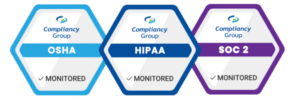OSHA Compliance Checklist for Dental Offices
OSHA’s enforcement authority extends to nearly every industry, including dental practices. One issue that complicates OSHA compliance for many organizations is the fact that OSHA’s safety standards for employees are the same for every industry. Obviously, there are different hazards and factors between a construction site and a dental office, so we’ve prepared guidance for developing an OSHA compliance checklist for dental offices to assist in your efforts to achieve compliance.
Sources for Building an OSHA Compliance Checklist for Dental Offices
An OSHA dental compliance checklist should be developed from healthcare-specific OSHA safety standards.
These OSHA dental safety checklist standards include:
- Hazard Communication Standard
- Bloodborne Pathogens Standard
- Ionizing Radiation Standard
- Exit Routes Standard
- Electrical Standards
- Emergency Action Plan Standard
- Fire Safety Standard
- Medical and First Aid Standard
For each of these standards, the OSHA compliance checklist for dental offices should include the following types of content:
- A description of that standard’s training requirements and questions that gauge whether the facility complies with these standards. Training requirements address how often training must be provided, who must give it, and what the training must cover.
- A description of that standard’s recordkeeping requirements. Many healthcare standards contain provisions for how long and where dental offices must keep training records. Some healthcare standards require the employer to create a safety plan or program. For example, the Emergency Action Plan Standard requires employers of more than ten employees to keep a copy of an emergency action plan on-site and readily accessible to employees. The OSHA dental compliance checklist should capture these requirements.
- Medical records. Healthcare standards often require employers to maintain employee medical records. For example, the bloodborne pathogens standard requires employers to keep records of individuals who have contracted Hepatitis B at work.
The standards describe what must be contained in these records and whether any of the information should be regarded as confidential. The OSHA dental office compliance checklist should include questions addressing employer compliance with retention and content of medical records.
- Sources of hazards. The checklist for any given safety standard should contain a list of sources of hazards the measure is designed to minimize. For example, the bloodborne pathogens standard checklist should describe the hazards – contaminated sharps, open wounds, accidental re-use of needles – to which the standard applies.
In addition, the checklist for each standard should cover what measures the employer is taking to mitigate hazards. Mitigation of hazards should first seek to eliminate the hazard. If that is not possible, employers should attempt to find an appropriate substitute for the hazard. For example, substitution could consist of replacing a cleaning agent known to be carcinogenic with one approved by the Environmental Protection Agency (EPA).
- Description of engineering controls, work practice (administrative) controls, and personal protective equipment. If a hazard cannot be eliminated or substituted, an employer must attempt to use engineering controls, which are attempts to isolate employees from a hazard. Engineering controls are methods that are built into the design of a plant, equipment, or process to minimize the hazard.
Engineering controls are a very reliable way to control worker exposures as long as the controls are designed, used, and maintained properly. The basic types of engineering controls are process controls, enclosure, isolation, and ventilation. Administrative controls (or work practice controls) are changes in work procedures such as written safety policies, rules, supervision, schedules, and training to reduce the duration, frequency, and severity of exposure to hazardous chemicals or situations.
If none of these methods lessen or mitigate the hazard, an employer can use personal protective equipment, which is gear and clothing employees wear to reduce the chance of exposure to hazards. Gloves, goggles, masks, gowns, aprons, and hard hats are all examples of personal protective equipment.
Things to Remember on Your OSHA Dental Compliance Checklist
Every dental office must have a written exposure control plan. It’s often referred to as the OSHA manual for dental offices. It outlines a strategy specific to the individual office of controlling exposure to any hazards employees face during their jobs. The plan should address items particular to each office (like whether you offer patients nitrous oxide), so you can’t just borrow another practice’s plan and expect to be covered.
Every employee must have access to the exposure control plan. One employee must be named as the OSHA coordinator and will supervise the practice’s compliance with OSHA standards.
OSHA has focused more in recent years on including measures that protect employees from workplace violence. Your written plans should include strategies for protecting employees from potential violence in the workplace instigated by other employees and visitors to your office.
Safety Data Sheets (SDS) must be available for every potentially hazardous chemical used in the office. These SDS must be current and kept in a location easily accessible by employees. It’s not enough just to have training about them. Any dental OSHA compliance checklist should include a review of SDS.
The same is true with something as simple as posting OSHA-mandated posters in the workplace. All of this should also be reflected in your organization’s policies and procedures, and records of everything done to achieve compliance must be kept as proof.







